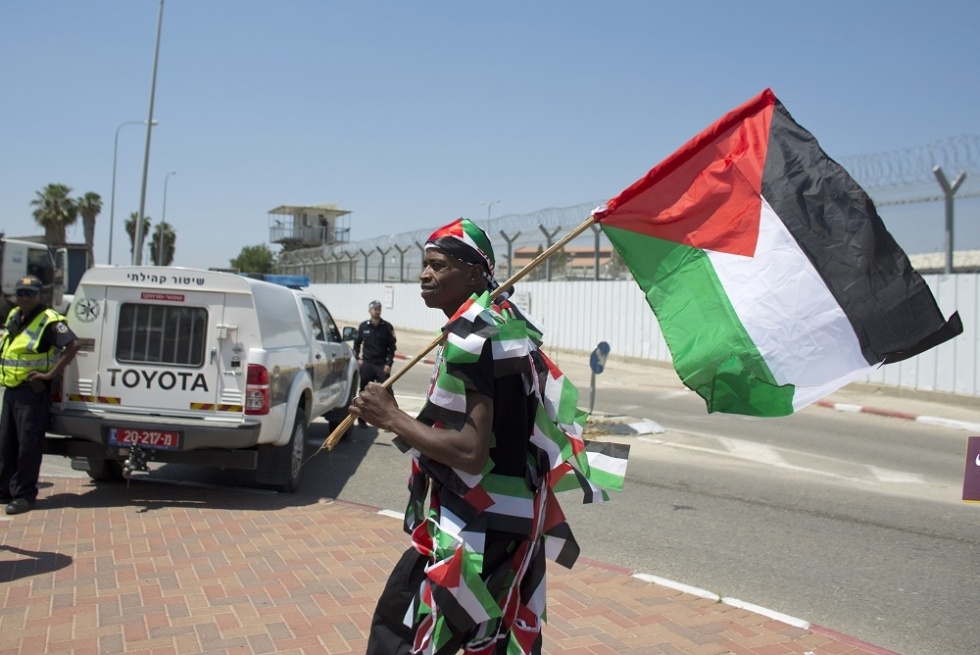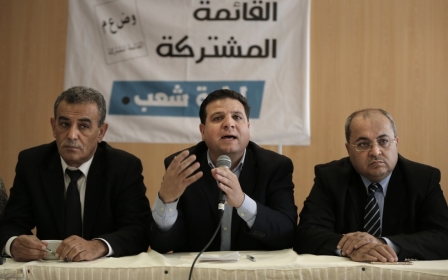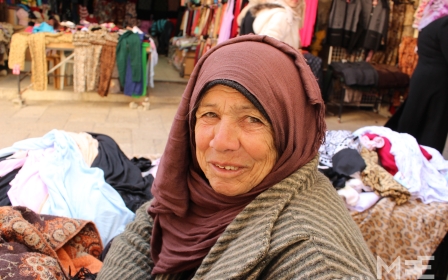Arab village of Dahmash fears being wiped off Israel’s map

DAHMASH, Israel - According to Israel’s official records, the 600 inhabitants of Dahmash village live a single building - one that no longer exists.
The villagers’ story may sound like the basis for a sinister fairy tale, but their plight is all too real.
Next week their case reaches Israel’s highest court and the outcome is likely to decide whether Dahmash, survives or is destroyed.
For decades officials have refused to recognise the village’s 70 actual homes, trapped between the towns of Ramle and Lod, and only 20 minutes’ drive from Tel Aviv, Israel’s most vibrant city.
Arafat Ismail, the village leader, said that while industrial parks, shopping malls and estates of luxury villas had sprung up all around them, Dahmash’s residents had been treated like “illegal squatters”.
Deprived of recognition in their own village, all the families have been registered as living in a building on the edge of the neighbouring town of Ramle. However, that house was destroyed years ago as nearby rail and road arteries expanded.
“Now, unless we can stop them, the authorities will wipe our real homes off the map too,” said Ismail, aged 54.
‘Stick in their throat’
What distinguishes Dahmash from the communities around it is that it is Arab, an apparently unwelcome relic from a time when the country was called Palestine.
Dahmash’s inhabitants belong to Israel’s large Palestinian minority, which is descended from those who managed to remain inside the borders of the new state of Israel in 1948.
Today, these 1.5 million Palestinian citizens comprise a fifth of Israel’s population, but complain of systematic discrimination. Most of their deprived communities are to be found in Israel’s so-called peripheries, in the north or south, out of view of most Israeli Jews.
But located in the midst of Tel Aviv and its satellite towns, “Dahmash is like a stick in their throat,” said Ali Shaaban, a Palestinian citizen of Israel, who raises sheep and goats in the village.
His own smartly appointed, two-storey home is one of 16 that face immediate demolition if the villagers lose next week’s court hearing.
Since the families were moved by the Israeli authorities to this location from other parts of the country shortly after the 1948 war, they have found Dahmash turned into an embattled enclave.
“It’s like they are slowly trying to squeeze us until we reach breaking point and leave,” said Shaaban, aged 53.
Such fears have only been heightened by bellicose statements from local officials. Yoel Lavi, Ramle’s long-time mayor, told a journalist in 2006 that the government should send in special armed units and military bulldozers as it does in the occupied territories.
“When you give the first shock with the crane everyone runs from their houses, don't worry," he said.
Hills of uncollected rubbish
Surrounded on all sides by the towns of Ramle and Lod and by an exclusively Jewish farming community called Nir Zvi to the north, Dahmash can be reached only by crossing a series of railway lines, along a potholed dirt track that floods through the long winter months.
Large piles of rubbish litter the streets and have to be burnt by residents, said Ismail, because Lod Valley Regional Council, which has jurisdiction over the area, refuses to take responsibility for the village.
A maze of jerry-rigged electricity and water lines, connected to a handful of the original buildings in Dahmash, provide a threadbare link to modern convenience.
“Imagine running six or seven homes off a supply line designed for just one,” said Shaaban.
Parents, meanwhile, have had to battle in the courts to get their children – with no recognised address – accepted into local schools. Petitions for a kindergarten, playground, park, health clinic and a cemetery have all been rejected.
Various family-run businesses in the village, including a scrap metal yard, car repair garages, taxi service and building merchant, have closure orders.
“It’s like we are invisible here, except when they want to make trouble for us or to demolish our homes,” said Shaaban.
He and the 20 other members of his family who share the same house have been living with just such a threat for the past decade.
In 2007, they were tipped off before massed ranks of police arrived to enforce the demolition of 13 homes. He and the other families managed to foil the effort by locking themselves into their homes.
In recent months, however, the threat is back in full force, as officials wait for the villagers to exhaust their last legal avenues before the courts.
“You go to bed, and you never know whether in the morning you will wake to find your house is about to be turned into rubble,” Shaaban said.
Oversight from 1948
The authority’s hostility, according to the villagers, derives from Dahmash’s exceptional status: it is the only Palestinian community that survived in central Israel from the period of the 1948 war.
Israeli historians have documented how Israel destroyed more than 500 Palestinian villages to prevent the return of some 750,000 refugees who had been expelled during the fighting. But allowing a Palestinian community to survive so close to Tel Aviv appears to have been an oversight.
Yitzhak Rabin, who would later become prime minister, recounted his experiences as the area’s military commander in 1948. In a censored section of his memoirs, revealed in the New York Times, he remembered how Israel’s first prime minister, David Ben Gurion, responded when asked what to do with the 50,000 surrendering Palestinians of Lydda and Ramleh - later to be reinvented as the Jewish towns of Lod and Ramle - neighbouring Dahmash.
“Ben Gurion waved his hand in a gesture that said: ‘Drive them out!’”
In an influential article published in the New Yorker in 2013, Israeli commentator Ari Shavit admitted that hundreds of Lydda’s residents were massacred by Israeli soldiers in Lydda and tens of thousands more driven out on a forced march to the West Bank.
In a historic assessment that appears to inform the authorities’ current concerns about Dahmash, Shavit concluded that the survival of Palestinian communities in the area was incompatible with the success of Israel as a Jewish state.
“From the very beginning,” he wrote, “there was a substantial contradiction between Zionism and Lydda. If Zionism was to exist, Lydda could not exist. If Lydda was to exist, Zionism could not exist.”
Ismail said: “What they carried out in 1948 was the ethnic cleansing of the Tel Aviv area. They left only Dahmash - now six decades later they are trying to complete the ethnic cleansing by destroying our village.”
According to Shaaban, the villagers would already have lost the legal battle had they not had the “tabu” - land deeds - showing that they are the owners. “Without those documents, we’d have been finished long ago,” he said.
Battle with planners
The Supreme Court hearing on 16 March – the same day as the Israeli elections - is the last stage in a planning battle the villagers began waging a decade ago to end the demolition threat, said their lawyer, Kais Nasser.
The village’s difficulties, he said, stemmed from a refusal by the planning authorities to discuss rezoning the land from agricultural to residential use, even though this had been done for neighbouring Jewish communities, including Nir Zvi, next door to Dahmash.
The planning authorities have rejected the villagers’ appeals for recognition, including the submission of a master plan in 2007 to allow for construction. Nasser said the interior ministry had failed to respond to his letters.
In their official response to the Supreme Court petition, government lawyers have called for the villagers to “move elsewhere”. Nasser said the implication is that they should buy homes in either Ramle or Lod.
Both are among a half dozen so-called “mixed cities” in Israel. In practice, they are Jewish towns with small “ghetto-like” Arab neighbourhoods, where unemployment, crime and drugs prevail.
Recent research suggested that 70 per cent of Arab homes in the two towns are illegal and under threat of demolition.
Yoav Beirach, a local academic who is among a group of Jewish solidarity activists supporting Dahmash’s struggle, said: “The issue of justice aside, moving from Dahmash to Lod or Ramle would probably be like jumping out of the frying pan into the fire.”
No new Arab community
In 2010, the central region’s planning committee concluded that there was “no justification for the creation of a new village in central Israel”.
“Officials say they are against encouraging new communities, but that only seems to apply to Arab communities,” said Nasser. “I have found five examples of the government establishing new communities for Jews in the last few years.”
Suhad Bishara, a planning expert with the Adalah legal centre in Haifa, said Israel had refused to create a single new Arab community since Israel’s establishment, despite a near 10-fold increase in the Palestinian population over that time.
Overcrowding and poor infrastructure was rife in the minority’s communities, she added.
Dahmash is one of several dozen Arab “unrecognised villages” across Israel, although the only one in the country’s centre. Most are Bedouin communities in the Negev.
The government officially shelved the Prawer Plan in late 2013 to forcibly move tens of thousands of the Bedouin off their ancestral lands in the Negev after the Palestinian minority mounted mass protests.
Harming property sales
A report by the New York-based Human Rights Watch on Dahmash in 2010 criticised the Israeli authorities for treating residents “as if they don't exist”.
It also noted that the planning process lacked transparency. Yoel Lavi, Ramle’s mayor, sat on the planning committee that rejected Dahmash’s master plan, despite his own efforts to initiate a new “flagship” neighbourhood of Ramle in 2004 over Dahmash’s only access road.
The report included comments from Lavi to Israeli TV in 2004 in which he warned that allowing Palestinians to live nearby would "harm the ability to market the project since people [Jews] won't want to live there."
He added that “93 percent of the Jewish population clearly prefers not to live in a mixed building”.
Ismail said the authorities had significantly stepped up their campaign of harassment in Dahmash after Lavi announced his plan.
Dahmash’s children have traditionally attended school in Ramle, where nearly a quarter of residents are from the Palestinian minority and their children attend a separate Arab education system.
However, in 2005 Lavi refused to provide Dahmash’s children with school transport, and a year later stop registering first graders. Lavi’s decision were overturned by the courts.
Both the interior ministry and Lavi’s spokesman, Roni Barzeli, were unavailable for comment.
Dahmash is due to stage a large music festival on Saturday to draw attention to its court case.
New MEE newsletter: Jerusalem Dispatch
Sign up to get the latest insights and analysis on Israel-Palestine, alongside Turkey Unpacked and other MEE newsletters
Middle East Eye delivers independent and unrivalled coverage and analysis of the Middle East, North Africa and beyond. To learn more about republishing this content and the associated fees, please fill out this form. More about MEE can be found here.




